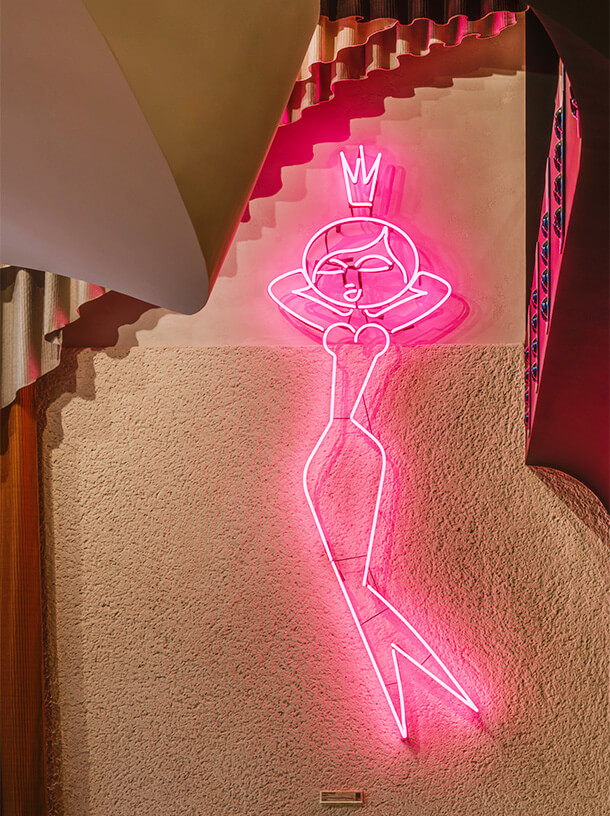Maurycy Gomulicki
The Pink Mermaid
neon, 2013

“The Pink Mermaid” is one of the artist’s earlier neons and the first to be unambiguously figurative. Created a decade ago in 2013, it was made especially for the “A Photo of the City: Warsaw Photography and Related Practices” exhibition, held in the Workshop Hall of the Nowy Theatre in Warsaw. Afterwards, it graced the façade of a building at 4 Mińska Street within a post-industrial complex, home to the LETO and Piktogram galleries, both actively cementing their presence in the capital’s art scene at the time. Ultimately, the work settled in its permanent home in Diuna complex.
“As a proud Varsovian and a dedicated admirer of femininity in all its diverse forms, I have a special fondness for our endearing mascot. Over time, I have created numerous mermaid designs in various styles, each with its own playful twist. However, this particular creation holds a distinct allure for me. Despite the modest coverage of her bust, her form is elegantly depicted with graceful arches. Adorned with two apples, she wears a long, form-fitting evening dress, exuding the timeless elegance reminiscent of a charming girl from the 1930s, evoking the spirit of Princess Adria. The design is done in such a way as to allow the tail to be interpreted as two legs, appearing tightly clasped at the knees, moving rhythmically to a swing rhythm. The whole thing is accentuated with a hairstyle reminiscent of Josephine Baker. The closed eyelids lend the face a playful, dreamy expression. I find this voluptuous and electric beauty quite captivating,” says Maurycy Gomulicki about his neon creation.
Maurycy Gomulicki – born in 1969, lives and works in Warsaw (PL) and Mexico City (MX).
Maurycy graduated from the Faculty of Graphic Arts at the Academy of Fine Arts in Warsaw and furthered his studies at the Universitat de Barcelona, Nuova Accademia di Belle Arti in Milan, and the Centro Multimedia del Centro Nacional de las Artes in Mexico. Gomulicki is a versatile artist, designer, photographer, collector, and anthropologist of popular culture, working across various media such as photography, sculpture, installation, video, animation, graphic design, and book illustration. He has also contributed to public space with a number of completed objects. Known as a consistent promoter of the Culture of Delight, Gomulicki often explores themes of eroticism, pornography, and fetish in his projects. Intense colour, examined for its vitality and sociocultural significance, is a significant element in his work. His artistic pursuits centre around the visual expressions of popular culture, blurring the distinctions between low and high culture.
Diuna Art Collection
Sculpture / Landscape / Form – Diuna
In Diuna project, we create the landscape as humans, it’s not created by nature, employing tools and quotations throughout the process. The resulting landscape isn’t and won’t be natural, yet it encompasses something more – a fusion of emotions, gestures, and an endeavor in composition that evokes a sense of harmony, even if it presents as an anomaly.
The anomaly evolves into a positive force, forging a new trajectory in shaping space, where materials and textures play a crucial role—initiating a sensory dialogue with human presence in a specific space. An integral element of this exchange is the inclusion of artists’ works within the spaces of the lobbies forming an additional stratum of Diuna’s landscape. Each artist interprets the landscape, lines, and gestures in a distinct manner, crafting fresh meanings that unfold across multiple dimensions.
The pieces from Jan Dziaczkowski’s “Mountains for Warsaw” collection displayed in lobby B is a poignant metaphor for the artist’s profound adoration for the mountains. They encapsulate a fulfilled dream, illustrating the hypothetical scenario of Warsaw nestled within mountainous terrain. Through these works, the artist delves into the cultural metamorphosis that accompanies a shift in landscape, a backdrop that significantly influences us. The juxtaposition of skyscrapers against the mountain backdrop enhances their allure, while the addition of a roller coaster leading to the Royal Castle constructs a vision of utopian tourism, ultimately attaining an iconic status. Janek’s envisioned landscape prompts us to recognize the pivotal role of our surroundings in shaping our emotions and aspirations.
Meanwhile, in Nikodem Szpunar’s showcased works in lobby C, the landscape transforms into a graceful gesture, crafted with a specially designed brush. These abstract yet intimately familiar creations exude tranquillity and harmony, akin to a form of grand calligraphy or meditation. They establish a seamless connection between us and the environment, fostering a sense of flow and unity.
A strikingly different piece, “The Bow” by Hannah Sophie Dunkelberg adds a touch of pop culture to lobby D, intriguing us with its unconventional form. While the bow may initially exude an air of sweetness and innocence, the material comprising it is sharp, angular, and weighty, imparting an aura of complexity and inaccessibility. Delving beneath the surface, the object challenges established norms and social expectations, offering a poignant commentary on the inherent difficulties that accompany notions of nicety and beauty. Yet, when viewed through the lens of space as compositions in a more organic light, the tribulationof conforming to conventions fade into insignificance.
The art collection is enriched by the presence of “The Pink Mermaid” in lobby A, a neon created by Maurycy Gomulicki in 2013. This piece seamlessly integrates with the theatrical ambiance of the lobby, combining distinct elements of expression that the artist passionately emphasizes in his work—neon pink hues and an admiration for the Warsaw mermaid, depicted here in an exquisitely feminine and even seductive form.
The resulting lobby landscapes A, B, C, and D form a subtle extension of the new outdoor patio space. The sculptures by Łoskiewicz Studio harmonize with the concept of intertwining our thoughts with nature, creating a space rich in complex details and textures, where emotions find tangible form. The ensemble evokes a contemporary temple, serving as a space where we seek dynamic harmony and balance, if only for a fleeting moment.
„Don’t try to understand it. Feel it.” – Tenet
